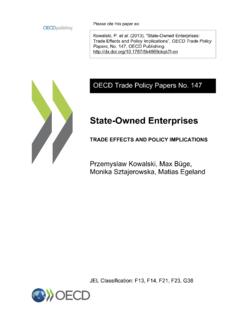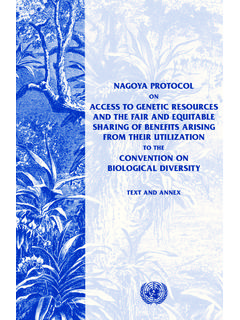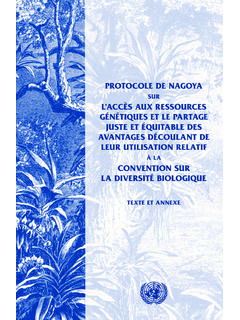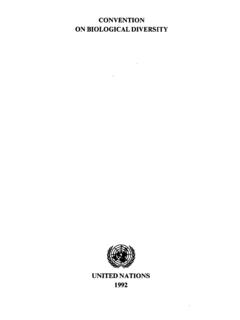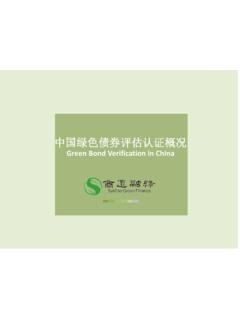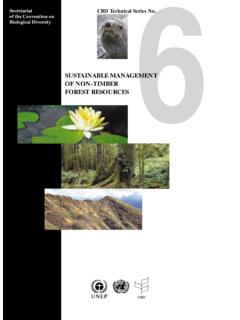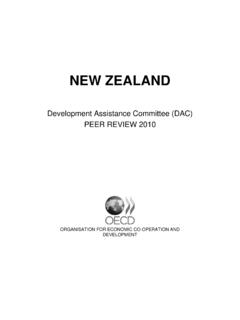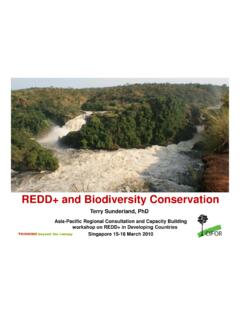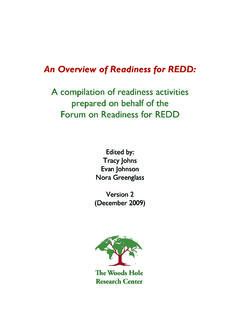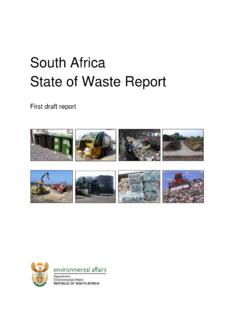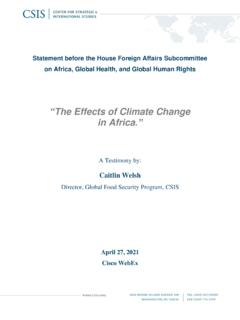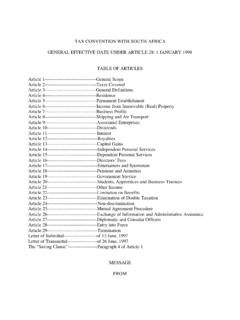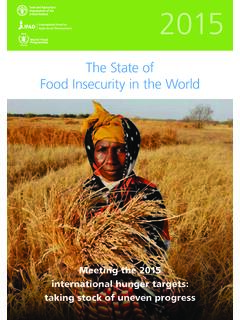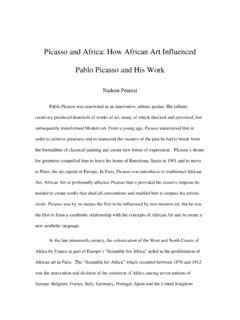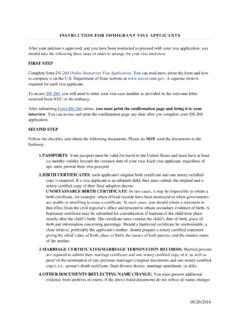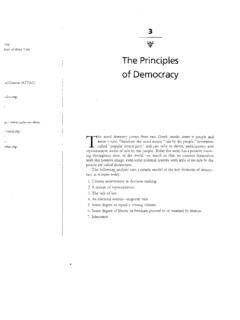Transcription of THE STATE OF BIODIVERSITY IN AFRICA
1 THE STATE OF BIODIVERSITY . IN AFRICA . A MID-TERM REVIEW OF PROGRESS. TOWARDS THE AICHI BIODIVERSITY . TARGETS. 1. 3. Neil Burgess Preparation Reproduction This study was commissioned by the Division of Environmental This publication may be reproduced for educational or Law and Conventions (DELC) of the United Nations non-profit purposes without special permission, provided Environmental Programme (UNEP) under the leadership acknowledgement to the source is made. Reuse of any figures of Ms. Elizabeth Maruma Mrema, DELC Director, and the is subject to permission from the original rights holders. No direct supervision of Ms. Kamar Yousuf, Regional BIODIVERSITY use of this publication may be made for resale or any other Multilateral Environmental Agreement (MEA) Focal Point commercial purpose without permission in writing from UNEP.
2 For AFRICA . Additional funding has been provided by the Applications for permission, with a statement of purpose and UNEP World Conservation Monitoring Centre (UNEP- extent of reproduction, should be sent to the UNEP-DELC. WCMC) and the Secretariat of the Convention on Biological Director, United Nations Environment Programme, Box Diversity (SCBD). The design, printing and distribution of 30552, Nairobi 00100, Kenya. this report was enabled through the financial contribution of the European Union. Disclaimer The contents of this report do not necessarily reflect the views Citation or policies of UNEP, contributory organizations or editors. The UNEP-WCMC (2016) The STATE of BIODIVERSITY in AFRICA : designations employed and the presentations of material in this A mid-term review of progress towards the Aichi BIODIVERSITY report do not imply the expression of any opinion whatsoever Targets.
3 UNEP-WCMC, Cambridge, UK. on the part of UNEP or contributory organizations, editors or publishers concerning the legal status of any country, territory, The United Nations Environment Programme World city area or its authorities, or concerning the delimitation of its Conservation Monitoring Centre (UNEP-WCMC) is the frontiers or boundaries or the designation of its name, frontiers specialist BIODIVERSITY assessment centre of the United Nations or boundaries. The mention of a commercial entity or product Environment Programme (UNEP), the world's foremost in this publication does not imply endorsement by UNEP. intergovernmental environmental organization. The Centre has been in operation for over 30 years, combining scientific Images and illustrations unless research with practical policy advice.
4 Otherwise credited. Published by the United Nations Environment Programme (UNEP), May 2016. Copyright UNEP 2016. ISBN: 978-92-807-3508-6. DEP/1924/CA UNEP promotes environmentally sound practices globally and in its own activities. Our distribution policy aims to reduce UNEP's carbon footprint. THE STATE OF BIODIVERSITY . IN AFRICA . A MID-TERM REVIEW OF PROGRESS. TOWARDS THE AICHI BIODIVERSITY . TARGETS. Acknowledgements This report was developed by Hilary Allison, Neil D. Burgess, We thank for their assistance in data and information Fiona S. Danks, Matthew Dixon, Brian O'Connor, Yara provision, interpretation and review: Roswitha Baumung Shennan-Farpon and Nanna G. Vansteelant (UNEP-WCMC).
5 (FAO); Albert Bleeker (International Nitrogen Initiative);. We thank the additional authors who contributed specifically Stuart Butchart (BirdLife International); Peder Engstrom to Target 9: Nick Holmes (Island Conservation); Geoffrey (University of Minnesota); Alessandro Galli (Ecological Howard (IUCN); Shyama Pagad (IUCN ISSG/Auckland Footprint); Chandra Giri (USGS); Taylor Gorham (MSC); Irene University); and David Will (Island Conservation). Hoffmann (FAO); Marion Karmann (FSC); Fridolin Krausmann (Alpen-Adria Universitat); Jan Legind (GBIF); Gregoire Leroy Contributions were received from Philip Bubb, Sarah Darrah, (FAO); Jonathan Loh (WWF/ZSL); Katie Longo (Ocean Health Erin Dillon, Mike Harfoot, Jerry Harrison, Diego Juffe-Bignoli, Index); Louise McRae (ZSL); Thomasina Oldfield (TRAFFIC).
6 Brian MacSharry, Lera Miles, Elina V n nen, Judith Walcott Shyama Pagad (IUCN ISSG/Auckland University); Tim and Matthew Walpole (UNEP-WCMC); Ogwal Sabino Merino Robertson (GBIF); Brooke Russell (Aid Data); Yichuan Shi Francis (National Environment Management Authority, (UNEP-WCMC); and all others who may have contributed Uganda); and Ellen Shepherd (independent consultant). to the process. Drafts were reviewed by Mohamed Abdel-Monem (UNEP-RO);. Tarek Ahmed (AFDB); Mohamed Al-Aawah (UNESCO);. Marco Barbieri (CMS); David Cooper (CBD Secretariat); Robert H ft (CBD Secretariat); Lisa Ingwall-King (UNEP-WCMC);. Kieran Noonan Mooney (CBD Secretariat); Chris Reij (World Resources Institute); Francisco Rilla (CMS); Frank Turyatunga (UNEP-DEWA); Melanie Virtue (CMS); Marceil Yeater (CITES).
7 And Kamar Yousuf (UNEP-DELC). We thank the reviewers for their comments and suggestions. We also acknowledge and thank Abby Symes and Grace Eun Hye (UNEP-DELC interns). for drafting the earlier versions. STATE OF BIODIVERSITY IN AFRICA . CONTENTS. Foreword.. iv 1. Executive Summaries.. 1. 2. Key messages about the STATE of BIODIVERSITY in AFRICA .. 13. STATE .. 13. Pressures .. 14. Responses .. 15. 3. The Strategic Plan for BIODIVERSITY 2011-2020 and its review .. 17. Summary of the findings of the GBO-4 .. 17. 4. Summary of progress towards Aichi BIODIVERSITY targets in AFRICA .. 19. Aichi BIODIVERSITY Target Dashboard .. 21. 5. Target by target analysis .. 23. Target 1: Awareness of BIODIVERSITY increased.
8 24. Target 2: BIODIVERSITY values integrated .. 26. Target 3: Incentives reformed .. 29. Target 4: Sustainable consumption and production .. 32. Target 5: Habitat loss halved or reduced .. 35. Target 6: Sustainable management of aquatic living resources .. 39. Target 7: Sustainable agriculture, aquaculture and forestry .. 41. Target 8: Pollution reduced .. 44. Target 9: Invasive alien species prevented and controlled .. 47. Target 10: Ecosystems vulnerable to climate change .. 49. Target 11: Protected areas .. 53. Target 12: Reducing risk of extinction .. 57. Target 13: Safeguarding genetic diversity .. 62. Target 14: Ecosystem services .. 64. Target 15: Ecosystem restoration and resilience.
9 67. Target 16: Access to and sharing benefits from genetic resources .. 69. Target 17: BIODIVERSITY strategies and action plans .. 72. Target 18: Traditional knowledge .. 76. Target 19: Sharing information and knowledge .. 78. Target 20: Mobilising resources from all sources .. 80. 6. Opportunities and recommendations for the future.. 83. 7. Conclusion .. 86. 8. References .. 87. A REVIEW OF PROGRESS TOWARDS THE AICHI BIODIVERSITY TARGETS i Distribution of main biomes and biogeographical realms (inset) on land in the AFRICA region (map produced by UNEP-WCMC. using data from Olson et al. 2001). ii STATE OF BIODIVERSITY IN AFRICA . Map of countries and their Economic Exclusive Zone (EEZ) in the AFRICA region, based on the UNEP Live regional classification (UNEP 2015a).
10 A REVIEW OF PROGRESS TOWARDS THE AICHI BIODIVERSITY TARGETS iii FOREWORD. AFRICA is immensely rich in BIODIVERSITY . Its living organisms comprise around a quarter of global BIODIVERSITY and it supports the earth's largest intact assemblages of large mammals, which roam freely in many countries. AFRICA 's biomes extend from mangroves to deserts, from Mediterranean to tropical forests, from temperate to sub-tropical and montane grasslands and savannahs, and even to ice-capped mountains. There are many examples of success and innovation in the conservation of AFRICA 's BIODIVERSITY , yet AFRICA is also experiencing unprecedented rates of population growth, urbanization and agricultural development, which create immense challenges in reconciling human well-being with environmental and economic prosperity.
